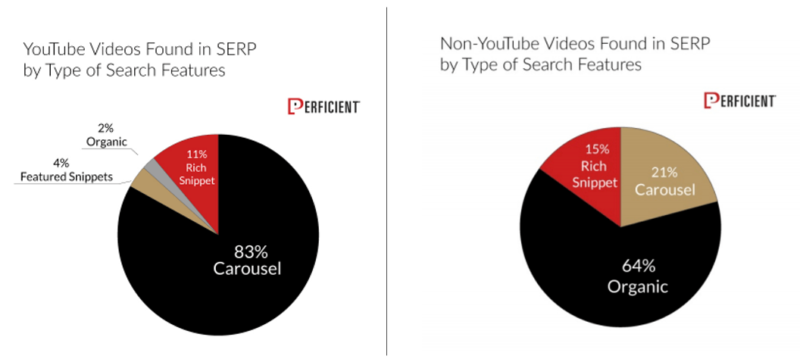YouTube remains dominant source of video in top Google ranking positions
Study found 83% of videos in search results carousel come from YouTube.
There’s a perception that Google favors YouTube content above other video sites in search results. A July, 2020 Wall Street Journal analysis found “Google searches placed YouTube videos first in video carousel results by an overwhelming margin . . . [compared with] other video platforms.”
An earlier search ranking study from 2017 by Perficient Digital concluded, “YouTube videos rank far more frequently in the top 10 than videos that are either self-hosted, or hosted on other video platforms.” And now a follow-up study by Perficient reaffirms these findings.
For its part, Google has repeatedly denied that it gives any preference to YouTube over other sources of video content. Google’s Gary Illyes previously said that YouTube ranks well because they “do good SEO, or their pages are structured in such a way that it’s easy for us to understand them and to rank.”
Google, YouTube Ranking algorithms ‘fundamentally different.’ In the current study, Perficient found that YouTube videos continue to “dominate the videos ranking within Google,” especially in video carousels. It also found that the ranking algorithms for video in Google search and on YouTube “are fundamentally different.”
The research examined Google search and YouTube rankings for the same roughly 6,100 search queries on both sites. The objective was to “evaluate YouTube’s dominance in the Google SERPs and how video rankings vary between YouTube and Google.” It determined the ranking algorithms of the two sites were quite different and the top ranked videos (from YouTube) in Google results didn’t correspond to YouTube rankings.
Where videos in Google search results appear

YouTube videos appear mostly in carousel. Videos can appear on Google in featured snippets, rich snippets, carousels and in general organic results. Perficient found that YouTube videos tended to mostly appear in the carousel, and to a lesser degree rich snippets, while videos from third party sites were more often found in organic results lower down on the page.
The study discovered that video rankings for the same queries were different in Google and on YouTube roughly 64% of the time. Perficient conjectures this has to do with differing user intent on the two platforms and different monetization strategies for each site.
Google has been consistently criticized by rivals for appearing to “favor its own content” in search results. That contention is at the heart of the current antitrust suit against the company. And the Perficient study provides more ammunition to the company’s critics.
Why we should care. Of potentially greater interest to many search marketers are Perficient’s video optimization recommendations for both Google and YouTube that also appear at the end of the report. Video remains and under-utilized strategy by many marketers, as well as another opportunity to rank in search results.
The study observes that videos tend to appear in Google results most often for “informational queries, tutorials and how-to queries, reviews and entertainment.” Query relevance and links are the two major ranking variables for video. However Perficient said, “we saw many instances of videos with weaker link profiles outranking other videos due to higher relevance.”
Contributing authors are invited to create content for Search Engine Land and are chosen for their expertise and contribution to the search community. Our contributors work under the oversight of the editorial staff and contributions are checked for quality and relevance to our readers. The opinions they express are their own.
Related stories
New on Search Engine Land